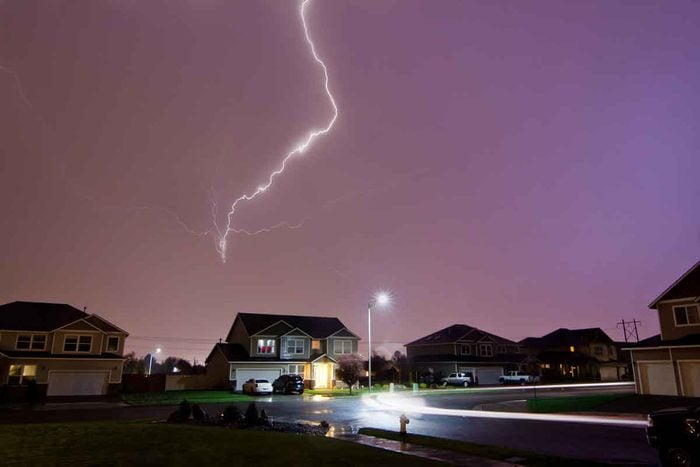How To Protect Your Home From Lightning Strikes
Updated: Mar. 07, 2024

Installing preventative measures that provide lightning protection will save you money in the long run.
In the U.S., the odds that you’ll be struck by lightning in your lifetime, if you live to be 80, are fairly low — 1 in 15,300. In fact, in 2020, there were only 17 verified, direct lightning strikes in the U.S. But the odds that lightning strikes your house are much higher, about one in every 200 houses in the U.S. per year. Last year, there were more than 70,000 lightning damage claims from homeowners in the U.S., with the average cost per claim at nearly $30,000. A lightning strike can cause a home fire or other physical damage, but it can also cause an electrical surge, which can damage your appliances and electronics. A few safety measures can save you a lot of money and headaches. If you protect your home from lightning, you may not even know it’s been struck, but if your defenses are down, you could be looking at a hefty repair bill that insurance may not cover.
On This Page
Whole-Home Surge Protection
A power surge can occur in many ways, including power outages and short circuits, however, lightning is the most destructive. A surge is a sudden increase in voltage within your electrical system. It can happen if there’s nearby lightning, even if it doesn’t directly strike your home. These surges can travel down power, phone or cable lines near your home. Large surges may cause immediate damage to your appliances. Over time, repeated smaller surges may damage your appliances until they eventually fail.
When it comes to protecting your home from electrical surges, you’ll want to install Surge Protective Devices (SPDs)* and a reliable electrical grounding system. These devices locate, block and divert the voltage away from your home, using metal oxide varistors. It’s a misconception that general-purpose power strips will protect your home’s appliances in the event of a strong surge. Power strips only extend your outlet’s capacity, while surge protectors create a barrier between your electrical system and the devices plugged into them. However, even then, a point-of-use surge protector is no match for a large, lightning-caused power surge, and is not a direct replacement for whole-house surge protection.
While installing a whole-home surge protector can cost around $300 to $600, it can save you thousands in the long run. It’s best to hire a licensed electrician to install your SPDs because they must be connected to your home’s electrical panel. Before installation, have the electrician check your home’s electrical grounding system. SPDs often divert voltage surges down into your home’s electrical grounding system so it’s very important that this system is updated, in good working condition and it provides a low-resistance pathway to the earth. The average fee for an inspection and installation is around $175.
* The installation of a whole-house surge protective device is the best option, but it’s fine to supplement the whole-house SPD with another point-of-use SPD (a surge-protection power strip) closer to the equipment or device, such as a computer workstation.
Lightning Rods
Lightning creates an insane amount of power and heat. Lightning rods, AKA air terminals, are one solution used by residential and commercial buildings to safely redirect those currents. Here’s how they work: A metal rod (or several rods) is placed at the peak of your home (or a building, like the Empire State Building). That rod is connected to a copper wire that runs down to the ground, linking up with another metal rod that’s buried underground. Via this path, the voltage is able to safely disperse into the Earth.
However, lightning rods are not a fail-safe option. At certain voltages, lightning rods simply cannot divert all of the energy, and some may travel down into your exposed home. And, lightning rods should also be installed by a professional and can cause an immense amount of damage if installed incorrectly. These systems can get pretty pricey too, at about $1,500 on average, for a copper six-rod system, installed.
Other Methods
Without these safeguards, there are a few additional precautions you can take when lightning is forecast. The easiest one? Unplug your devices. Create a lightning plan with your family to ensure all major appliances and devices are protected or unplugged.
Devices to unplug
- TVs
- Computers
- Gaming systems
- Charging stations
- Portable appliances
Some large appliances, like the washer, dryer and stove, often can’t be easily unplugged before every storm. In these instances, avoid using the plugged-in appliances during the peak of the storm.
Surge protective devices can be installed at the main electrical panel and help to protect against over-voltage and fires. DIY installation should be attempted with caution. If you have any doubts, hire a pro. These whole-panel surge arrestors are affordable too, at less than $100, depending on how much protection you need (or how big your home is). As mentioned before, investing in surge-protected power strips for your plug-in appliances and devices is a budget-friendly preventative measure that will give you peace of mind.
